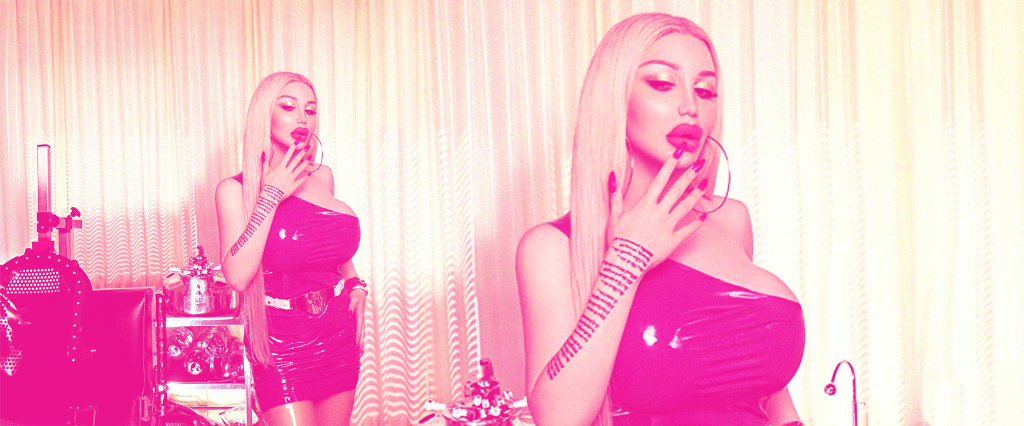Fake boobs. Blonde hair. Microscopic waists. Pink lipgloss. These are the hallmarks of the bimbo — per Merriam-Webster, an attractive but stupid young woman. The term has generally been a pejorative, but in recent years, some women have turned it into a fringe identity — to the delight of the men who get off on women transforming themselves in such fashion.
Originating from the Italian word “bambino,” or baby, bimbo was first used in reference to attractive, curvaceous and unintelligent women as early as the 1920s. But it’s probably most associated with a set of scandals in the 1980s. Jessica Hahn, the church secretary who in the late 1980s accused televangelist Jim Bakker of rape, probably embodied the media definition of the bimbo best. Vilified for her looks and accusations against Bakker, Hahn said in a 1987 interview with Playboy: “This is supposed to be the year of the bimbos, right? So let’s start with the fact that I am not a bimbo… I know that’s how people see me, but I am not what I’ve been made out to be — someone without thoughts or feelings or explanations. I am a human being.”
More modern bimbos, though, have embraced the label. Katie Rose, for example, promotes herself on Instagram as a Bimbo Barbie. “Do you have to be men-obsessed, cock-obsessed? No, you don’t. Do you have to be dumb? No, you don’t. A bimbo is whoever you want to be,” she says in the YouTube video below. Breast cancer was the catalyst for her getting 800ccs of silicone implants (roughly double the average amount). Everything else, though — her affinity for the color pink, the tight clothing and fake nails and lips — is by design and what she refers to as “plastic positive.”
For Alicia Amira, another popular online bimbo and body modifier, getting a fake butt, boobs and lips was just the start. She eventually plans to have her ribs removed for a smaller waist and her fingers sewn together like a doll’s hand, too. This process — a waif-y, brown-haired bookworm transforming into a proportionally unsound blonde in lucite heels after losing all ability to think for herself — is the biggest part of the appeal for men with a bimbo kink.
That said, Amira identifies as a feminist, as she exercises her free will to achieve a certain look — even if that look is an exaggerated version of Jenna Jameson. In an Instagram post, she reiterates Rose’s assertion that anyone can be a bimbo, plastic surgery or not. “I’m scared that many change their looks out of hate and not about interest. It’s all about self-love in my opinion,” she says.
Still, for many bimbos, to be a sex object is the goal. What it means to be a sex object, though, varies. For example, one redditor, Reiinapop, practices both bimbofication and feederism, in which she sexualizes gaining weight while having fake boobs, lip injections and the like. She documents both of these fetishes on Reddit and YouTube, adding to a small but active niche of YouTube fetishists. Among them are videos of “bimbo hypnosis,” in which a soft female voice trances you into mindless, big-breasted oblivion.
The idea behind bimbo hypnosis is that a woman becomes hypnotized by these videos, loses her intellectual capacities, and as a result, undergoes physical changes like an inflated chest or skimpier clothes. It supposedly looks a little something like this:
Regardless of the starting point, the end result of the transformation always seems to be the furthest extreme of hypersexual femininity.
Instagram user BimboficationNow identifies as a sort of “bimbofication coach” and occasional sugar daddy. The appeal of bimbos for him is “the act of a certain woman enhancing themselves to try and be sexier, the level of over-sexification — the obsession with looking good.” He’s been running his bimbo admiration account since 2015, and he says it’s definitely becoming more and more popular. “It’s just finally bimbofication time,” he explains. He thinks it’s the culmination of a number of things — primarily the advent of Instagram and the normalization of plastic surgery through celebrities like Kylie Jenner and reality shows like Botched.
Plus, social media stars like Chloe Khan (who doesn’t identify as a bimbo, though BimboficationNow cites her as one) show that there’s the possibility of fame and money in emphasizing a bimbo aesthetic.
Psychologically speaking, there isn’t a single reason why women pursue the bimbo lifestyle. Often, it has to do with an image familiar to them as little girls, particularly Barbie. Others were simply unhappy with their appearance. For the rest, there’s no reason at all. “To me, being a bimbo is someone who is beaming with confidence, has sex appeal and is desired by others. As for myself, most of my life, I was overweight and never had that kind of attention or look. It was something I’ve always admired but never thought I could pursue,” Instagram user @bambi.bimbo.doll writes me via DM.
Bambi.Bimbo.Doll, also known as BimboInTraining_ on Reddit, currently has 500cc implants, but her goal is to achieve 1,600ccs, which will take multiple surgeries. She began the bimbofication process in earnest in March. The end, however, is far from near—in large part because of her fellow bimbos. “The online community is amazing and has helped me so much. The love and support I get from them was so unexpected, but very much appreciated,” she says. “Seeing fellow bimbos gives inspiration and motivation to achieve the goals I have for myself.”

